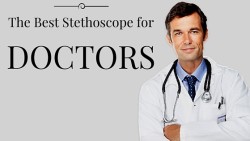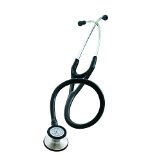The Ultimate Diagnostic Tool?
"We are getting more and more distanced from our patients."
"It [new handheld ultrasounds] would be the demise of the stethoscope. It'll be a problem."
"In the end, it's not going to be one versus the other. It's going to be, how do you fit the new technology in with the old?"
Dr. Lyall Higginson, Ottawa cardiologist
"Some of the protocols [like medical training in auscultation] tend to be a bit on the casual side -- taking students around to listen to a couple of patients in a clinic, and maybe listening to a couple of recordings."
"You can find out how fast the heart is going and measure blood pressure [with a stethoscope], but you can't really look directly at the function of the left ventricle [heart's pumping chamber]."
Dr. John Finley, pediatric cardiologist, Dalhousie University
"There are conditions where physical findings are very obscure. And often we end up requiring an ultrasound to confirm a physical finding anyway."
"So, you can argue you can actually jump one step, and save time [with the use of the new handheld ultrasound technology]."
Dr. Chi-Ming Chow, staff cardiologist, St. Michael's Hospital, Toronto
 |
The Vscan is a portable and pocket-size ultrasound device that allows cardiologists to do imaging at the point of care.
Source: Scripps Health
|
It was a delicate matter; how to listen to a patient's heart without giving offense, when a male physician was treating a female patient. In 1816, Dr. Rene Theophile Hyacinthe Laennec faced that dilemma with an elderly and very overweight female patient. He recalled a phenomenon of acoustics: "If you place your ear against one end of a wood beam the scratch of a pin at the other end is distinctly audible." He wrote this in his paper De l'Auscultation Mediate.
How he solved his little dilemma was recalling that bit of arcane knowledge and responding to it by rolling 24 sheets of paper into a tight roll, one end of which he placed on the patient's chest, the other to his ear. He was then "surprised and elated to be able to hear the beating of her heart with far greater clearness than I ever had with direct application of the ear", which up until that time was routine; a doctor placing his ear directly on a patient's chest to listen to the heart to aid in his diagnosis.

And thus was the stethoscope born. Born and brought into popular usage across Europe and then North America. As for Dr. Laennec, described as a "diminutive, asthmatic and very shy" doctor and just incidentally a tuberculosis specialist, he died at the unfortunately early age of 45, in 1826, aged 45. His innovation lived long after him, and the medical profession has had great reason to be grateful for his iconic moment of invention.
Doctors are never, ever seen without that icon of diagnosis slung around their necks, for the stethoscope has been used as an indispensable tool ever since. Examine a patient and the stethoscope has pride of place in the doctor's little black bag of necessary accoutrements. It has taken two hundred years for modern technology to arrogantly bring into the field of medicine a replacement for the reliable, sturdy stethoscope. Of course, any instrument is only as good as the human using it.
And as it happens, as technology brings along changes that it harrumphs in triumph improve everything -- it also dumbs down those special senses and operating capabilities that people were exposed to, to become proficient in their use -- to make us entirely reliant on a mechanical device to give us the data that a skilled professional could once deduce. Where once general practitioners were known to be indeed generalists, capable of doing just about anything that medical science offered, they have now become specialists in doing little other than referring on to other medical professionals.
And even then, the routine examination that patients were exposed to as the hands, eyes and ears of the practising physician focused on the physiognomy presented at any given time along with probing the patient's narrative to gain a diagnosis, now the doctor is more likely to be focused on the computer sitting before him as he interviews the patient while engaging in an absolute minimum of hands-on exploratory check-ups.

So now there is discussion among health professions, some of whom are pro-scope, others who are wedded to any and all types of emerging, useful and accurate technology whose use has led to doctors whose skills are nowhere near those of the preceding generations who took pride in practising medicine as a healing art extraordinaire. There are studies suggesting that the hand-held ultrasound devices' diagnostic capacities are more accurate than with the use of the mere stethoscope.
Indeed, one study saw first-year students exposed to 18 hours of training with the ultrasound technology correctly identifying more cardiac abnormalities than the trained cardiologists whose preference was the use of traditional stethoscope examinations. It's like the new self-driving vehicles where drivers have the impression they no longer have to bother being alert and capable of driving on their own, becoming passengers in cars driven mechanically as the cars themselves become robots.
The doctors who took their training seriously and devoted their professional lives to practising medicine with pride and professionalism are capable of turning an experienced ear to what they hear with the agency of the humble stethoscope. Where a normal murmur, vibration-like, signifies normalcy and a whooshing sound signals potential problems. What happens when the electrical grid fails or batteries are unavailable, and doctors schooled in the use of the hand-held devices must turn to the stethoscope?
Just asking.

0 Comments:
Post a Comment
<< Home